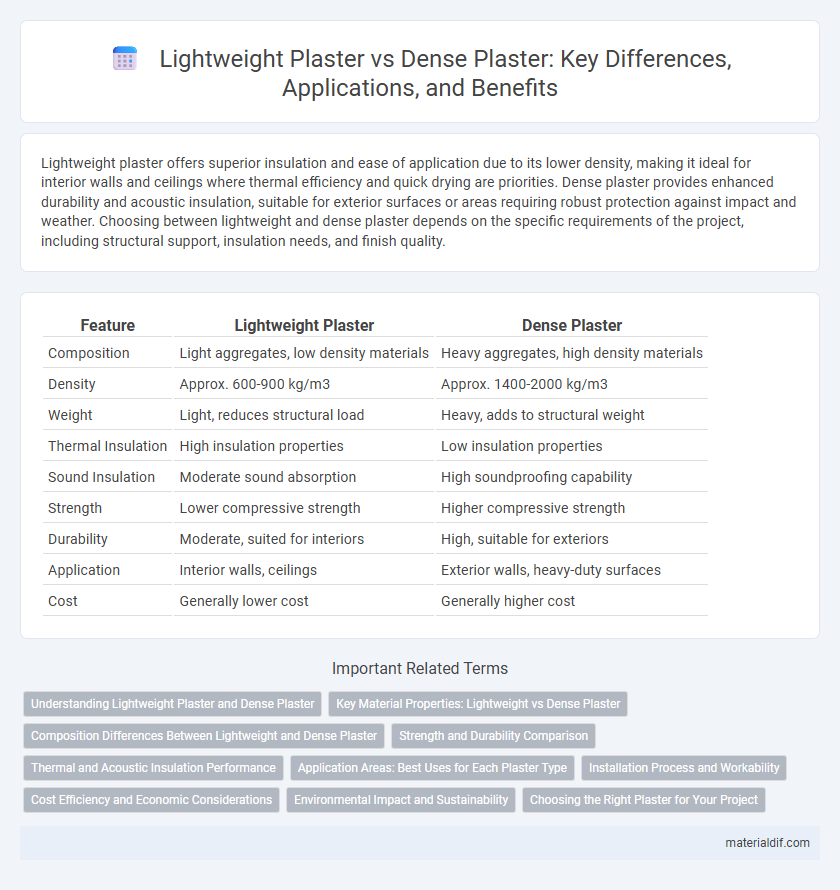Lightweight plaster offers superior insulation and ease of application due to its lower density, making it ideal for interior walls and ceilings where thermal efficiency and quick drying are priorities. Dense plaster provides enhanced durability and acoustic insulation, suitable for exterior surfaces or areas requiring robust protection against impact and weather. Choosing between lightweight and dense plaster depends on the specific requirements of the project, including structural support, insulation needs, and finish quality.
Table of Comparison
| Feature | Lightweight Plaster | Dense Plaster |
|---|---|---|
| Composition | Light aggregates, low density materials | Heavy aggregates, high density materials |
| Density | Approx. 600-900 kg/m3 | Approx. 1400-2000 kg/m3 |
| Weight | Light, reduces structural load | Heavy, adds to structural weight |
| Thermal Insulation | High insulation properties | Low insulation properties |
| Sound Insulation | Moderate sound absorption | High soundproofing capability |
| Strength | Lower compressive strength | Higher compressive strength |
| Durability | Moderate, suited for interiors | High, suitable for exteriors |
| Application | Interior walls, ceilings | Exterior walls, heavy-duty surfaces |
| Cost | Generally lower cost | Generally higher cost |
Understanding Lightweight Plaster and Dense Plaster
Lightweight plaster offers enhanced thermal insulation and ease of application due to its lower density, making it ideal for reducing wall weight in construction. Dense plaster provides superior durability and sound insulation, suitable for high-traffic areas requiring robust surface protection. Understanding the composition and typical use cases of lightweight versus dense plaster helps optimize building performance and material efficiency.
Key Material Properties: Lightweight vs Dense Plaster
Lightweight plaster exhibits low density, enhanced thermal insulation, and superior ease of application, making it ideal for interior walls and ceilings where weight reduction is crucial. Dense plaster, with higher density and compressive strength, provides superior durability, sound insulation, and impact resistance, suitable for exterior surfaces and high-traffic areas. The choice between lightweight and dense plaster depends on balancing thermal performance, structural strength, and application requirements.
Composition Differences Between Lightweight and Dense Plaster
Lightweight plaster is primarily composed of gypsum or lime combined with perlite, vermiculite, or pumice, which introduces air pockets and significantly reduces density, improving insulation and ease of application. Dense plaster, in contrast, contains higher proportions of sand and cement, resulting in a robust and heavy mixture that offers superior strength and durability for structural or exterior applications. The key compositional differentiation emphasizes lightweight fillers for reduced weight versus coarse aggregates and binding agents to achieve density and mechanical resilience.
Strength and Durability Comparison
Lightweight plaster offers ease of application and thermal insulation but provides lower strength and durability compared to dense plaster. Dense plaster contains higher cement and sand ratios, resulting in superior compressive strength and enhanced resistance to weathering and mechanical stress. For structural surfaces and high-traffic areas, dense plaster is preferred due to its long-lasting performance and robustness.
Thermal and Acoustic Insulation Performance
Lightweight plaster offers superior thermal insulation due to its porous structure, which traps air and reduces heat transfer, making it ideal for energy-efficient buildings. Dense plaster exhibits enhanced acoustic insulation by its mass and density, effectively dampening sound transmission and improving noise control in interior spaces. Balancing these properties helps architects select plaster types tailored for specific thermal and acoustic performance requirements.
Application Areas: Best Uses for Each Plaster Type
Lightweight plaster is ideal for interior walls and ceilings in residential buildings due to its ease of application and thermal insulation properties. Dense plaster, with its higher durability and moisture resistance, suits external surfaces, bathrooms, and high-traffic areas requiring robust protection. Selecting plaster depends on environmental exposure and structural needs, optimizing performance and longevity.
Installation Process and Workability
Lightweight plaster offers easier application due to its reduced weight and enhanced workability, making it ideal for quicker installations and less labor-intensive projects. Dense plaster requires more precise mixing and application techniques to ensure proper adhesion and durability, often extending installation time. The improved flow and spreadability of lightweight plaster reduce drying cracks and allow for smoother finishes compared to dense plaster.
Cost Efficiency and Economic Considerations
Lightweight plaster offers enhanced cost efficiency by reducing material usage and labor time, making it ideal for large-scale projects with tight budgets. Dense plaster, while more expensive due to higher raw material content and longer drying times, provides superior durability and sound insulation, which can lower long-term maintenance costs. Selecting between lightweight and dense plaster depends on balancing initial investment against the economic benefits of durability and application requirements.
Environmental Impact and Sustainability
Lightweight plaster reduces environmental impact by requiring less raw material and energy during production, resulting in lower carbon emissions compared to dense plaster. Its improved thermal insulation properties contribute to energy efficiency in buildings, decreasing overall operational carbon footprints. Dense plaster, while durable, often entails higher material consumption and energy demands, making it less sustainable in large-scale applications.
Choosing the Right Plaster for Your Project
Lightweight plaster offers excellent thermal insulation and ease of application, making it ideal for interior walls and ceilings where weight reduction is crucial. Dense plaster provides superior durability and soundproofing, suited for high-traffic areas and exterior surfaces requiring robust protection. Selecting the right plaster depends on project requirements such as environmental exposure, structural support, and desired finish quality.
Lightweight Plaster vs Dense Plaster Infographic

 materialdif.com
materialdif.com